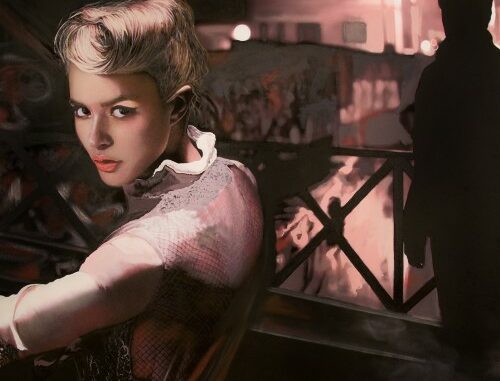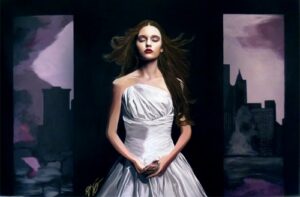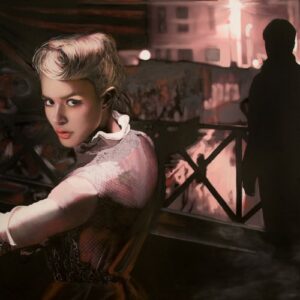
Interviewer: R. Weisberg, MFA, University of California at San Francisco
Gina, what is your definition of “American Noir?”
American Noir is my modern interpretation of the movie genre of the 40s and 50s. I’m incorporating the aesthetic aspects of film noir and making them current. When most people hear the term “film noir” they think of retro black and white melodramas, low-key lighting, crime dramas and such; but actually film noir’s influence has never really left. Directors like David Lynch, Quentin Tarantino, and Jim Jarmusch were obviously influenced by film noir. To me, it’s an intoxicating art form, not only visually, in terms of the lighting and camera angles, but also the archetypal characters and moral dilemmas in these movies leave a powerful impact on the viewer. American Noir is my personal representation of some of these elements that have touched me as an artist.

What do your paintings depict and what’s your process?
My art is figurative. If I were to use adjectives I would say elegant, mysterious, melancholy women and men juxtaposed against urban backgrounds. In regard to my process, I have hundreds of sketches and ideas, all inspired by whatever music I’m listening to at the time — it’s usually 90s Grunge or Rachmaninoff’s piano concerto no. 2. I can’t create without music. If you’re asking if I do a traditionally planned out sketch on canvas like most artists, the answer is no, and that’s for the same reason I use acrylics instead of oils. Acrylics dry very fast; it forces me to be spontaneous and uncontrived. I know in the first few hours of painting if something is working; if not, I move on and the canvas will be re-worked later or I’ll sulk about it and it will be discarded. I paint on rolls of canvas tacked to board and only stretch them when I like the end result. I don’t varnish them until they’ve been photographed.
Can you describe how much film noir movies have directly influenced your subject matter?
Film noir movies have made a subconscious impression on me. By that I mean they have influenced the mood of my paintings — an inspiration, not an actual depiction of movie scenes, so the influence is an undertone rather than an overt representation. I use color and tone to suggest a noir feel. Certainly the nocturnal settings and intrigue is deliberate. I’ll often put a shadowy figure in the paintings, which I suppose could be interpreted as an direct influence – either that or some Jungian neurosis I’m not consciously aware of.
Some of the work is strongly emotional. Are you telling a story? I mean, do you actually have a story in mind when creating these paintings?

That’s an interesting question. I always begin a canvas with a particular feeling I want to evoke, rather than a planned composition. I prime the canvas deep blue, and I’ll sketch out in chalk just the key elements. The rest comes together in my mind as I’m working. It’s my intention that the paintings depict “moments” rather than stories – I would rather evoke a story than tell one, because if my evocation inspires the viewer to create a story, all the better. The experience should be a 2-way process. Hopefully my work is provocative.
If words could describe your painting style, what would they be and why?
My “style” is a combination of controlled and spontaneous. I purposely blend realistic figures with expressionistic backgrounds. I try to infuse a sense of elegance. The subject matter is nocturnal. – I’m just more creative at night and I suppose the final result reflects this. I paint using several halogen lamps instead of sunlight.
I know you did fashion illustrations for some of the top designers. The figures in your works have a mixture of classical and contemporary ideas of fashion, so which illustrators influenced you and in what way? Who were your artistic influences?
I began my career as a fashion illustrator. Antonio Lopez was a big influence, but perhaps even more so, I was drawn to the photographers. My father was a commercial photographer in Los Angeles in the late 70s. He graduated from Art Center College of Design. Ansel Adams had been one of the teachers there years earlier, and my dad had all these Aperture magazines I used to look at. I was fascinated watching him print his photos, with all the different tubs of chemicals, the dark room, even the photo paper that had to be refrigerated. As a child, I found the whole process to be very magical. I loved Edward Steitchen, Irving Penn. I remember I was fascinated by a print called “The Tarot Reader.” I suppose I’m a purest in general. I’m not a big fan of digital art. Photographically speaking, I prefer the look of film to digital because I can better see the artist behind the lens. To me, good art is not 1-dimensional. You should be able to feel the whole artistic process when looking at a piece of art — all the elements that were re-worked, any tears shed, or moments when everything comes together beautifully, it all goes to create a depth of feeling, to move the viewer, and isn’t that really what art is all about?
What advice would you give an artist just starting out, and what was the main reason you wanted to become an artist?
What advice would I give? – Follow your passion, but be prepared for the consequences; artists don’t have easy lives. If you’re looking for money, be a stock broker. While sharing your paintings gives other pleasure, creating them, at least for me, is a selfish process. Keep your eyes open and be aware of everyone and everything around you. Noticing sadness in a stranger’s eyes is just as important as memorizing the way light hits an object. You need both to create a good piece of art, if you know what I mean by that. Also, keep in mind that while creating art is noble and passionate, selling art is a business. To be a successful artist you need to not only be creating to the best of your ability, but also avidly working on marketing your art, which involves working with other people. I have seen many of my contemporaries demonstrate terrific talent, all gone to waste because of petulance, inflexibility, or the inability to coexist in the business world. I don’t remember ever consciously deciding to be an artist; it just happened. I definitely believe that being raised in an atmosphere of art, my parents were both artists, helped to validate what I already felt. There is nothing in the world that gives me as much pleasure as creating art. That I can create art and make a living creating – I couldn’t possibly ask for more.
You can see more of Gina’s work at www.ginahiggins.com and www.opiumeyespublishing.com

Great interview, beautiful work.
I like the advices.